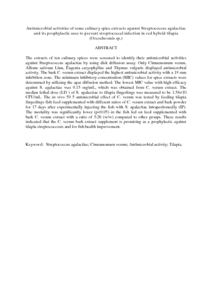Citation
Alsaid, Milud and Mohd Daud, Hassan and Bejo, Siti Khairani and Abuseliana, Ali
(2010)
Antimicrobial activities of some culinary spice extracts against Streptococcus agalactiae and its prophylactic uses to prevent streptococcal infection in red hybrid tilapia (Oreochromis sp.).
World Journal of Fish and Marine Sciences, 2 (6).
pp. 532-538.
ISSN 2078-4589; ESSN: 2078-4600
Abstract
The extracts of ten culinary spices were screened to identify their antimicrobial activities against Streptococcus agalactiae by using disk diffusion assay. Only Cinnamomum verum, Allium sativum Linn, Eugenia caryophyllus and Thymus vulgaris displayed antimicrobial activity. The bark C. verum extract displayed the highest antimicrobial activity with a 18 mm inhibition zone. The minimum inhibitory concentration (MIC) values for spice extracts were determined by utilizing the agar diffusion method. The lowest MIC value with high efficacy against S. agalactiae was 0.15 mg\mL, which was obtained from C. verum extract. The median lethal dose (LD50) of S. agalactiae to tilapia fingerlings was measured to be 1.56×105 CFU/mL. The in vivo
antimicrobial effect of C. verum was tested by feeding tilapia fingerlings fish feed supplemented with different
ratios of C. verum extract and bark powder for 17 days after experimentally injecting the fish with S. agalactiae
intraperitoneally (IP). The mortality was significantly lower (p<0.05) in the fish fed on feed supplemented with
bark C. verum extract with a ratio of 3:26 (w/w) compared to other groups. These results indicated that the C. verum bark extract supplement is promising as a prophylactic against tilapia streptococcosis and for fish health improvement.
Download File
![[img]](http://psasir.upm.edu.my/25700/1.hassmallThumbnailVersion/Antimicrobial%20activities%20of%20some%20culinary%20spice%20extracts%20against%20Streptococcus%20agalactiae%20and%20its%20prophylactic%20uses%20to%20prevent%20streptococcal%20infection%20in%20red%20hybrid%20tilapia.pdf)  Preview |
|
PDF (Abstract)
Antimicrobial activities of some culinary spice extracts against Streptococcus agalactiae and its prophylactic uses to prevent streptococcal infection in red hybrid tilapia.pdf
Download (85kB)
| Preview
|
|
Additional Metadata
Actions (login required)
 |
View Item |

